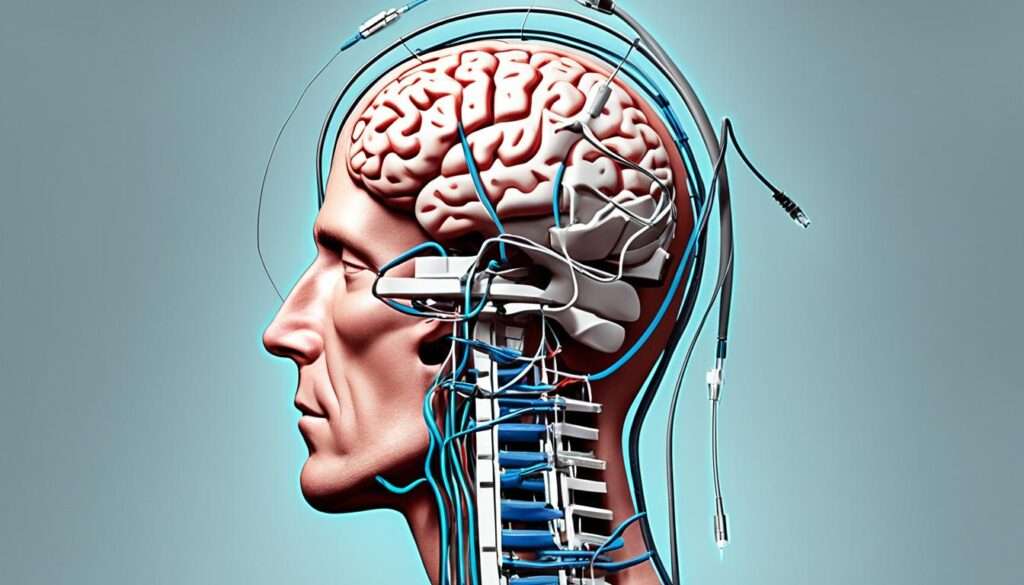If you or a loved one are dealing with cervical dystonia, also known as spasmodic torticollis, you know how challenging it can be to manage the symptoms. The good news is that there are effective treatment options available to help alleviate the pain, tremors, and abnormal neck posturing associated with this condition.
When it comes to cervical dystonia treatment, one of the most effective options is botulinum toxin (BoNT) injections. These injections provide selective denervation and relaxation of the affected neck muscles, leading to significant improvement in symptoms. BoNT injections are the gold standard treatment and can be repeated every three to four months for long-lasting benefits.
In addition to BoNT injections, oral medications can be used as adjunct therapy for cervical dystonia. While not as effective as BoNT injections, these medications have a muscle-relaxing effect and can help improve symptoms to some extent. However, they may come with side effects that need to be considered.
In cases where other treatments have failed to provide sufficient relief, deep brain stimulation (DBS) may be an option. DBS is a surgical therapy that involves implanting a wire into the brain to deliver electrical pulses and disrupt the abnormal nerve signals causing the head to twist. This treatment is considered when other options have been exhausted.
Aside from medical interventions, there are other treatment modalities and coping strategies that can help manage cervical dystonia. These include sensory tricks, such as touching the opposite side of the face or the back of the head, which can temporarily alleviate symptoms. Heat packs, massage, and exercises that improve neck strength and flexibility may also be beneficial. Additionally, managing stress is important as it can exacerbate symptoms.
In conclusion, there are effective treatment options available for cervical dystonia. BoNT injections are the most widely used and provide selective denervation and relaxation of the affected neck muscles. Oral medications and deep brain stimulation are other options to consider. With the right treatment approach and support from healthcare professionals, it is possible to manage symptoms and improve quality of life.
Table of Contents
ToggleBotulinum Toxin Injections: The Most Effective Treatment
When it comes to treating cervical dystonia, botulinum toxin (BoNT) injections have proven to be the gold standard. This treatment offers significant relief from symptoms and has become the go-to option for patients seeking effective cervical dystonia treatment.
BoNT is injected directly into the affected neck muscles, targeting the source of the problem. By selectively denervating the muscles, BoNT injections induce relaxation and improve neck alignment, leading to a reduction in dystonia-related symptoms.
This treatment is not only highly effective but also well-tolerated by patients. The injections are typically administered every three to four months, ensuring the continuous management of symptoms and the maintenance of optimal relief.
| Treatment | Effectiveness | Tolerance | Treatment Frequency |
|---|---|---|---|
| Botulinum Toxin Injections | Significant improvement in symptoms | Well-tolerated | Every three to four months |
| Oral Medications | Modest improvement in symptoms | May come with side effects | Varies depending on the medication |
| Deep Brain Stimulation | Suitable for refractory cases | Surgical procedure with potential risks | Ongoing management |
Table: Comparison of Cervical Dystonia Treatment Options
If you’re considering cervical dystonia treatment, it’s important to consult with a healthcare professional who can assess your condition and determine the most appropriate course of action. BoNT injections offer a reliable and proven solution for effectively managing cervical dystonia symptoms and improving your quality of life.
Oral Medications as Adjunct Therapy
Oral medications can be used as an adjunct therapy for cervical dystonia when botulinum toxin injections are not practical or desired. These medications have a muscle-relaxing effect and can help improve symptoms to some extent. However, it’s important to note that the effects of oral medications for cervical dystonia are more modest compared to botulinum toxin injections.
While oral medications can provide some relief, they often come with side effects that may limit their use. It’s essential to work closely with your healthcare provider to determine the best course of treatment and manage any potential side effects.
Common Oral Medications for Cervical Dystonia
Here are a few common oral medications that may be prescribed as part of a cervical dystonia treatment plan:
- Tizanidine: Tizanidine is a muscle relaxant that works by blocking nerve signals and reducing muscle spasms. It can help alleviate some of the symptoms associated with cervical dystonia.
- Baclofen: Baclofen is another muscle relaxant that can be used to reduce muscle stiffness and spasms. It acts on the central nervous system to provide relief.
- Trihexyphenidyl: Trihexyphenidyl is an anticholinergic medication that can help control muscle movements and reduce dystonic symptoms. It works by blocking certain neurotransmitters in the brain.
It’s important to remember that the effectiveness of oral medications can vary from person to person. Your healthcare provider will closely monitor your response to the medication and may make adjustments to the dosage or switch to a different medication if needed.
Combining Oral Medications with other Treatment Modalities
While oral medications may not be as effective as botulinum toxin injections, they can still play a valuable role in managing cervical dystonia symptoms when used in combination with other treatment modalities. Your healthcare provider may recommend a combination approach tailored to your specific needs.
In addition to oral medications, physical therapy and regular exercise can help improve muscle strength and flexibility, contributing to better symptom management. Heat packs, massage, and relaxation techniques may also provide temporary relief from muscle tension and discomfort.
Remember, it’s crucial to work closely with your healthcare team to find the most effective treatment plan for your cervical dystonia. They will consider your individual needs and preferences to develop a comprehensive approach that best suits you.
| Oral Medication | Function | Common Side Effects |
|---|---|---|
| Tizanidine | Blocks nerve signals and reduces muscle spasms | Drowsiness, dizziness, dry mouth |
| Baclofen | Reduces muscle stiffness and spasms | Drowsiness, weakness, nausea |
| Trihexyphenidyl | Controls muscle movements and reduces dystonic symptoms | Dry mouth, blurred vision, constipation |

Deep Brain Stimulation for Refractory Cases
When Other Treatments Fall Short
For individuals with refractory cervical dystonia, deep brain stimulation (DBS) offers a surgical therapy that targets the root cause of the condition. When other treatments have failed to provide sufficient relief, DBS may be considered as an alternative option. This procedure involves the implantation of a thin wire into the brain, which delivers electrical pulses to disrupt abnormal nerve signals responsible for the twisting of the head.
By directly targeting the source of the problem, DBS aims to alleviate the symptoms of cervical dystonia and improve the patient’s quality of life. While the complete mechanism of action is not fully understood, studies have shown that DBS can provide significant relief for refractory cases.
Considerations and Effectiveness
Deep brain stimulation is typically recommended when individuals have exhausted other treatment options without achieving satisfactory results. It is important to note that DBS is a surgical procedure and requires careful evaluation and selection of suitable candidates by a qualified healthcare professional.
The effectiveness of DBS in refractory cervical dystonia treatment has been documented in various studies. Research has demonstrated significant improvements in dystonia severity, reduced pain, and enhanced motor function in patients who have undergone this procedure.
Exploring Risks and Benefits
As with any surgical intervention, DBS carries potential risks and should be thoroughly discussed with the healthcare provider. Some potential risks include infection, bleeding, device-related complications, and adverse events associated with brain surgery. However, the overall benefit-risk profile of DBS for refractory cervical dystonia can be favorable for eligible individuals.
| Advantages | Considerations |
|---|---|
| – Potential for significant symptom improvement | – Requires a surgical procedure |
| – Offers an alternative for individuals with refractory dystonia | – Potential risks and complications |
| – Can enhance quality of life and motor function | – Need for careful patient selection |
It is essential for patients to have a comprehensive discussion with their healthcare team to fully understand the potential benefits and risks of DBS for refractory cervical dystonia treatment.

Other Treatment Modalities and Coping Strategies
In addition to botulinum toxin injections, oral medications, and deep brain stimulation (DBS), there are other treatment modalities and coping strategies that may help manage cervical dystonia. These approaches aim to alleviate symptoms, improve daily functioning, and enhance overall well-being.
Sensory Tricks
One effective strategy is the use of sensory tricks. These tricks involve touching certain areas of the body to temporarily alleviate symptoms. For example, some individuals find relief by lightly touching the opposite side of their face or the back of their head. This can help relax the muscles and reduce abnormal posturing.
Heat Packs and Massage
Applying heat packs to the affected neck muscles can provide relief by reducing muscle tension and promoting relaxation. Massage therapy, especially when performed by a trained professional, can help alleviate muscle stiffness, improve blood circulation, and relieve pain associated with cervical dystonia.
Neck Strengthening and Flexibility Exercises
Engaging in neck strengthening and flexibility exercises can help improve muscle control and reduce the severity of cervical dystonia symptoms. Physical therapists can provide guidance on specific exercises that target the affected muscles. These exercises may include stretching, range of motion exercises, and resistance training.
Stress Management Techniques
Stress often worsens the symptoms of cervical dystonia. Therefore, incorporating stress management techniques into daily life can be beneficial. Practices such as deep breathing exercises, meditation, yoga, and mindfulness can help reduce stress levels and promote relaxation. It is important to find activities that work best for you.
| Treatment Modality | Description |
|---|---|
| Sensory Tricks | Use of specific touches to alleviate symptoms temporarily |
| Heat Packs and Massage | Application of heat packs and therapeutic massage to relax muscles |
| Neck Strengthening and Flexibility Exercises | Exercises targeting neck muscles for improved control and flexibility |
| Stress Management Techniques | Practices to reduce stress levels and promote relaxation |
Implementing a combination of these treatment modalities and coping strategies can help individuals with cervical dystonia better manage their symptoms and improve their quality of life. It is important to consult with a healthcare professional to determine the most suitable approaches for your specific needs.

Conclusion
Cervical dystonia is a challenging condition that can significantly impact your quality of life. The good news is that effective therapies are available to help manage your symptoms.
Botulinum toxin injections have emerged as the most effective treatment for cervical dystonia. These injections provide selective denervation and relaxation of the affected neck muscles, leading to improved symptom management. Additionally, oral medications and deep brain stimulation are viable options for refractory cases.
Aside from these medical interventions, there are other treatment modalities and coping strategies that can complement your treatment plan. Sensory tricks, heat packs, massage, and exercises that improve neck strength and flexibility can help alleviate symptoms. Stress management techniques are also important, as stress can worsen symptoms.
It is crucial that you work closely with your healthcare team to find the most suitable treatment approach for your specific needs. By utilizing these effective therapies and incorporating symptom management strategies into your daily routine, you can improve your quality of life and regain control over cervical dystonia.
FAQ
What is cervical dystonia?
Cervical dystonia, also known as spasmodic torticollis, is a common adult-onset focal dystonia characterized by abnormal neck posturing, tremors, and pain.
What is the treatment of choice for cervical dystonia?
The treatment of choice for cervical dystonia is botulinum toxin (BoNT) injections, which provide selective denervation and relaxation of the affected neck muscles.
How effective are botulinum toxin injections in treating cervical dystonia?
Botulinum toxin (BoNT) injections are the gold standard treatment for cervical dystonia, providing significant improvement in symptoms. BoNT is injected directly into the affected neck muscles and causes selective denervation, resulting in relaxation and improved neck alignment.
How often do botulinum toxin injections need to be repeated for cervical dystonia?
Botulinum toxin injections for cervical dystonia usually need to be repeated every three to four months.
Are there other treatment options for cervical dystonia?
Yes, other treatment options for cervical dystonia include oral medications and deep brain stimulation (DBS) for refractory cases.
How effective are oral medications for cervical dystonia?
Oral medications can be used as adjunct therapy for cervical dystonia, especially when BoNT injections are not practical or desired. These medications have a muscle-relaxing effect and can help improve symptoms to some extent.
What is deep brain stimulation (DBS) and when is it considered for cervical dystonia?
Deep brain stimulation (DBS) is a surgical therapy offered to patients with refractory cervical dystonia. In this procedure, a thin wire is implanted into the brain, and electrical pulses are delivered to disrupt the abnormal nerve signals causing the head to twist. DBS is considered when other treatments have failed to provide sufficient relief.
Are there any other treatment modalities and coping strategies for cervical dystonia?
Yes, there are other treatment modalities and coping strategies that may help manage cervical dystonia. These include sensory tricks, such as touching the opposite side of the face or the back of the head, which can temporarily alleviate symptoms. Heat packs, massage, and exercises that improve neck strength and flexibility may also be beneficial. Stress management techniques are important as stress can exacerbate symptoms.
Source Links

This article is medically reviewed by Dr. Chandril Chugh, Board-Certified Neurologist, providing expert insights and reliable health information.
→ Book a consultation to discover which remedies suit your needs best.
About Author | Instagram | YouTube | Linkedin
Related Blog Posts
Recognizing Early Signs of Cervical Dystonia
May 17, 2024
Cervical Dystonia Symptoms: Early Signs and Relief
April 16, 2024
Effective Dystonia Cervical Treatment Options
April 3, 2024
Optimal Cervical Dystonia Treatments
March 23, 2024




